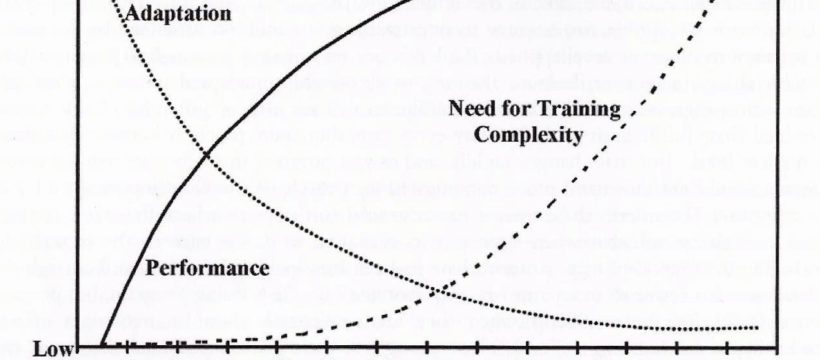Generally speaking, performance, rate of adaptation, and complexity of programming are all interrelated. This image is take from Mark Rippetoe’s Starting Strength and illustrates this:
How does this relate to climbing? Well, we know that one of the limiting factors on performance at upper ranges in climbing is grip strength.
This is why Grippul’s metrics for hand strength are so interesting is because they show that grip strength is somewhat linearly correlated to overall bouldering ability. For example, in the above link, 30% of bodyweight on one hand is equivalent to about V3, 50% of bodyweight on one hand is equivalent to about V5, 70% of bodyweight on one hand is equivalent to about V7, and so on up to about V13 or so.
Of course, this is a small sample size, and there are other factors such as core strength, leg strength, overall upper body strength, and such that are not accounted for. However, this gives us somewhat of a decently accurate summary on grip strength and performance.
What this would naturally look charted against the same chart above is here:
Where the V-grade intersects with the performance metric is where you would “generally” be able to climb that grade.
In the example above, it would take
- about 1.5 months total to go from V0-3
- about 4.5 months total to go from V0-7
- about 7.5 months total to go from V0-9
- about 12 months total to go from V0-11
- about 18 months total to go from V0-12
- about 24 months total to go from V0-13
- about 36 months total to go from V0-14
- about 48 months total to go from V0-15
- about 108 months total to go from V0-16
Obviously, in a “real” climber this would be a pretty insane rate development, and I’m sure there are a couple of genetic freaks out there that have climbed similar to this schedule. Something more realistic would starting from the V0-2 range would probably look something like this:
- about 1-2 months total to go from V0-2
- about 3-4 months total to go from V0-4
- about 4-12 months total to go from V0-6
- about 9-24 months total to go from V0-7
- about 18-42 months total to go from V0-8
- about 30-60 months total to go from V0-9
- about 48-84 months total to go from V0-10
- about 72-120 months total to go from V0-11
However, the illustration of the point is that the first few grades of development take proportionally far less time than it does to advance at the high(er) grades of development. This is because rate of adaptation as you get toward genetic potential is logarithmic.
Anyway, not really sure where I was going with this, but it’s a good visualization for newer climbers to understand. A newer climber going from V0 to V6 in a year might take another year to go from V6 to V7 or V8. It’s easy to get frustrated with plateaus and length of time to advance a “grade,” but that’s where good training comes into play.
Overall, this is how performance will go. Those will “more talent” (see: genetics) will likely progress much more rapidly than someone with “less talent” all things considered. However, everyone should not be dissuaded by things like genetics or talent and work to do their best in the sports or disciplines of their choice.
Original reddit post on /r/climbharder.
Author: Steven Low
Steven Low is the author of Overcoming Gravity: A Systematic Approach to Gymnastics and Bodyweight Strength (Second Edition), Overcoming Poor Posture, Overcoming Tendonitis, and Overcoming Gravity Advanced Programming. He is a former gymnast who has performed with and coached the exhibitional gymnastics troupe, Gymkana. Steven has a Bachelor of Science in Biochemistry from the University of Maryland College Park, and his Doctorate of Physical Therapy from the University of Maryland Baltimore. Steven is a Senior trainer for Dragon Door’s Progressive Calisthenics Certification (PCC). He has also spent thousands of hours independently researching the scientific foundations of health, fitness and nutrition and is able to provide many insights into practical care for injuries. His training is varied and intense with a focus on gymnastics, parkour, rock climbing, and sprinting. Digital copies of the books are available in the store.
